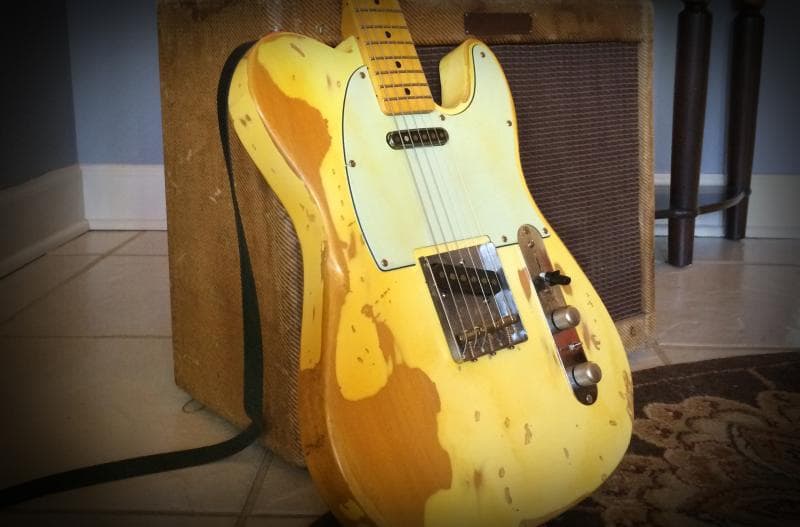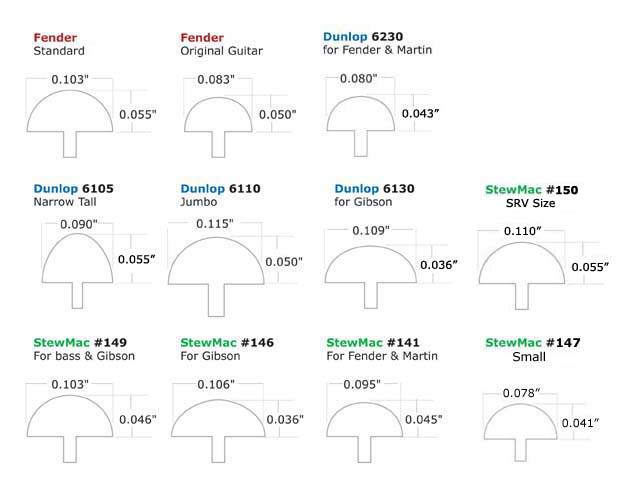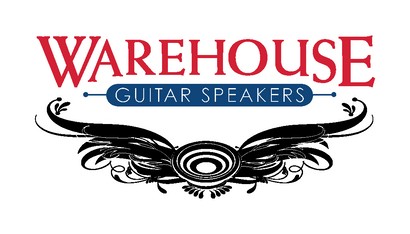Your Cart is Empty
NOW FREE SHIPPING TO 48 CONTIGUOUS UNITED STATES ON ALL ORDERS!!!
How Frets Affect Tone, Intonation, and Playability
by vaughn skow April 28, 2016 4 min read

As a bit of an artistic diversion, I “make” a few guitars every now and then, a habit I’ve had since I made my first guitar in Jr. High wood shop at age 15. Lately, I’ve been making Tele style guitars, since Nashville guitar slingers need top-shelf hard-core road guitars at a working-man’s price. There seem to be plenty of Strats in this category, but Tele’s … not so much. The process of making vintage Tele style guitars has really brought fret size to the forefront; as the traditional 3-saddle bridge really makes intonation difficult, which makes fret selection extra-important. At a later date, I’ll delve into what separates world-class Tele ELECTRONICS from the simply mediocre; but for now, let’s talk frets.

First: a note: while some of what we are discussing here relates to both acoustic as well as electric guitars, we are specifically talking about ELECTRIC guitars at this time! So a good place to start where frets are concerned would be a basic frame-of-reference; problem is, there is no such thing! Over the 70 years or so of the modern electric guitar’s life, quite a variety of frets have made finger-board appearances. So, dispel the belief that there is a “normal” that can apply to ALL electric guitars. There are a few very GENERAL observations that can be made, however.
Here is the single most important nugget, taken from an earlier blog my buddy Dave Hunter did on this topic: “While larger frets do seem to result in a rounder tone, perhaps with increased sustain too, they also yield a somewhat less precise note than narrower frets”. Please read Dave’s fine blogfor his always dead-on thoughts on this topic!
So there ya have the view from 50,000-feet! Big frets = bigger tone, smaller frets equal more precise intonation. Ah, if it were just that easy; if there were only TWO fret sizes … big ones for those who want maximum tone, especially on single-string big bend solos, and small ones for those who want precise intonation. But take a look at this fret size chart, and understand that these are ONLY the most common guitar fret sizes! Yea, these waters are getting murky!

So first of all, let’s eliminate the extremes on BOTH sides.
Yes, we have heard about Stevie Ray’s using enormous “bass” fret wire on some of his guitars, something his long-time guitar tech says is hogwash … but he DID play big frets, but unless you also plan to play with the huge strings he played with and only in HIS style, don’t even consider it! On the other end of the spectrum is the infamous Norlin-era Gibson “fretless wonders” of the 1970’s. With frets so small you “won’t even know they are there”. Again, unless you only play chords and play VERY light gauge strings, don’t even THINK about going there! So, that leaves us …
“Big frets”
For MOST guitar players, this will translate into either Dunlop 6110 “Jumbo” or Stewart-MacDonald’s #150 (SRV). These are the frets to go for if you DO want the tone and playability of someone like SRV, and if you are willing to sacrifice a little precise intonation on chords for a big ballsy tone on single-note bends. Also remember, big frets require big strings! As far as I’m concerned Jumbo frets arte only for medium gauge or bigger strings … unless you play very lightly, you will undoubtedly bend chords out of tune with light-gauge strings and big frets … ugg!
“Small frets”
Like Pre-CBS Fender’s and modern Dunlop 6230 or Stew-Mac #141 & 147. These are the frets for folks who are picky about tuning and are precise players. I especially like these frets on a Tele with a vintage 3-saddle bridge, as intonation is so compromised on these guitars anyway! Inverse to the big frets, I’d say these are for those who use light(ish) gauge strings … say 10’s or smaller.
“Somewhere in-between”
This is what most “modern” guitars are equipped with, like the Fender “standard” size and Dunlop 6130. And, I believe these frets are a great “best of both worlds” compromise on most any Strat or Les-Paul style guitar. They bend nicely, offer full-bodied tone, intonate fairly accurately, and are friendly to all but the most extreme string sizes. There is a reason why the major manufacturers have almost all adopted this fret size as their standard … it just works!
As for stupidly wide or tall frets, I would certainly avoid them unless you really don’t care about intonation or play stupidly lightly. But always remember: these are just my recommendations. Folks have really taken the fret thing to extremes with scalloped fret-boards … and then there is the “glitter” guitar that is ALL fret ... with no fret-board at all ... but I’m gonna say these just flat ain’t for everybody!

Leave a comment
Comments will be approved before showing up.
